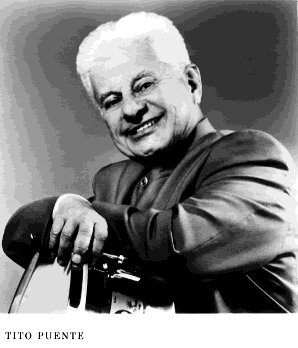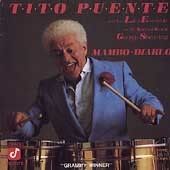
"Tito Puente is to Latin music what Beethoven is to classical."
Meet one of the greatest and most famous musicians in Latin music,
Tito Puente. Learn about the story behind this legendary musician and his glorious career that spammed over decades with over 100 albums and 10,000 live performances around the world.
by Eddie & Catherine
"Tito Puente is to Latin music what Beethoven is to classical."
-Hector Rosario, Stereotimes, 2000
Tito Puente's name should be no stranger to any latin music lover or latin dancers.
Ernesto Antonio Puente, Jr. (1923-2000), otherwise better known as Tito Puente, Sr. was an influential latin jazz and mambo musician. So lengendary is his music that he has been acclaimed to be "El Rey del Timbal (The King of Timbal)", "The King of Latin Music" and "The King of Mambo".
He is best known for dance-oriented mambo and Latin jazz compositions that helped keep his career going for 50 years. He and his music appear in many films including The Mambo Kings and Fernando Trueba's Calle 54 . He also guest starred on several television shows including The Crosby Show and The Simpsons.
. He also guest starred on several television shows including The Crosby Show and The Simpsons.
The Beginnings
Born on 20 April 1923 in New York City, Puente’s artistic talents first developed in the field of dance. In 1935, he and sister Anna became members of “Stars of the Future” a neighborhood artistic organization. On four occasions, Tito was honored for his exceptional dance ability.
After hearing a solo by Cuban pianist, Anselmo Sacassas, Tito began his musical education on the piano. Occasional tutors were Victoria Hernandez, sister of Puerto Rico’s legendary composer Rafael Hernandez and Luis Varona of the Machito orchestra who later would play with Tito’s orchestra. He also studied drums and idolized Gene Krupa. He later mastered the alto sax and was as accomplished on the vibraphone.
Puente then went on to work with Cuban pianist and bandleader Jose Curbelo beginning in December of 1939. Curbelo became his first music mentor and perhaps more importantly taught Puente the fundamentals of the music business. He then played with Johnny Rodriguez, Anselmo Sacassas, the musician that had inspired his piano study, and the great Noro Morales.In June 1942, he joined the Machito orchestra. Machito became Puente’s primary musical mentor. At one point, Tito left Machito to play percussion for the Jack Cole dancers.
Soon thereafter, he was drafted into the Navy and served in World War II. He played saxophone and drums with the band on the ship. He learned how to arrange music from a pilot that played sax. After 3 years, he was discharged with a Presidential Commendation for serving in nine battles. He returned to New York to work again with Curbello, Brazilian band leader Fernando Alvarez, featuring Charlie Palmieri on piano, and Pupi Campo. The GI Bill allowed him to study music at Juilliard School of Music, where he completed a formal education in conducting, orchestration and theory.
The "Cuban"
In 1949, Puente formed his own band the Piccadilly Boys. In the 1950s during the Palladium era, Tito Puente’s band was one of the top three orchestras in New York City, along with the orchestras of Machito and Tito Rodriguez. Mambo and cha-cha-cha were the rage at the time. At the height of his popularity, Puente helped to bring Afro-Cuban and Caribbean sounds, like mambo, son, and cha-cha-cha, to mainstream audiences (he was so successful playing popular Afro-Cuban rhythms that many people mistakenly identify him as Cuban). Dance Mania , possibly Puente's most well known album was released in 1958.
, possibly Puente's most well known album was released in 1958.
Puente later moved into more diverse sounds, including pop music, bossa nova and others before eventually settling down with a fusion of Afro-Cuban and Latin jazz genres that became known as "salsa" (a term that he reportedly disliked). He had strong leanings toward jazz which he “Latinized”. Puente later led two groups; an orchestra and a jazz ensemble. He continued to record both Latin jazz and straight-ahead Latin music with many different artists and his own bands.
Awards & Recognition
In 1979, he won the first of five Grammy Awards for his Homenaje a Beny Moré album which was a tribute to the Cuban singer Beny More. Other Grammy awards came in 1983 for On Broadway
album which was a tribute to the Cuban singer Beny More. Other Grammy awards came in 1983 for On Broadway ; 1985 for Mambo Diablo
; 1985 for Mambo Diablo ; 1990 for Gosa Mi Timbal; and in 2000 for Mambo Birdland
; 1990 for Gosa Mi Timbal; and in 2000 for Mambo Birdland . The New York Times chose Puente’s Dance Mania as one of the 25 most influential albums of the 20th century.
. The New York Times chose Puente’s Dance Mania as one of the 25 most influential albums of the 20th century.
In 1990, Puente was honored with a star on the Hollywood Walk of Fame and awarded the "James Smithson Bicentennial Medal" in the same year. He was also featured in the 1992 film “The Mambo Kings”. He was then given the National Medal of Arts by then President Clinton in 1997 and recognised by the Library of Congress in April of 2000 as a Living Legend. These are but some of the numerous awards and honorary degrees that are too many to list.
The Eternal Legend
After a heart attack following a show in Puerto Rico, Puente had heart surgery in New York City, from which he never recovered. He passed away on May 31, 2000, just a few months after shooting for the music video of Calle 54.
Throughout his career, he had recorded more than 100 albums, published more than 400 compositions, won five Grammy awards, had over 2,000 arrangements to his credit and performed to audiences around the world in more than 10,000 live performances.
Recent Discography
Mambo Beat: The Progressive Side of Tito Puente (1994)
Mambo y cha cha cha (1994)
The Best of Dance Mania (1994)
Barbarabatiri (1994)
Tito Puente's Golden Latin Jazz All Stars (1994)
Top Percussion/Dance Mania (1994)
20 Mambos/Take Five (1995)
Fania Legends of Salsa Collection, Vol. 3 (1995)
Fiesta con Puente (1995)
Jazzin (1995)
Mambo Mococo (1949-51) (1995)
Mambos with Puente (1949-51) (1995)
More Mambos on Broadway (1995)
Tea for Two (1995)
The Complete RCA Victor Revolving Bandstand... (1995)
Tito's Idea (1995)
Yambeque: The Progressive Side of Tito Puente (1995)
Cha Cha Chá: Live at Grossinger's (1996)
El Rey de la Salsa (1996)
El Rey del Timbal (1996)
Special Delivery (1996)
The Very Best of Tito Puente & Vicentico.. (1996)
Greatest Hits (1996)
Jazz Latino, vol. 4 (1996)
Percussion's King (1997)
Selection of Mambo & Cha Cha Cha (1997)
50 Years of Swing (1997)
Tito Meets Machito: Mambo Kings (1997)
Cha Cha Cha Rumba Beguine (1998)
Dance Mania '98: Live at Birdland (1998)
The Very Best of Tito Puente (1998)
Timbalero Tropical (1998)
Yambeque (1998)
Absolute Best (1999)
Carnival (1999)
Colección original (1999)
Golden Latin Jazz All Stars: In Session (1999)
Latin Flight (1999)
Latin Kings (1999)
Lo mejor de lo mejor (1999)
Mambo Birdland (1999)
Rey (2000)
His Vibes & Orchestra (2000)
Cha Cha Cha for Lovers (2000)
Homenaje a Beny Moré. Vol. 3 (2000)
Dos ídolos. Su música (2000)
Tito Puente y su Orquesta Mambo (2000)
The Complete RCA Recordings. Vol. 1 (2000)
The Best of the Concord Years (2000)
Por fin (Finally) (2000)
Party with Puente! (2000)
Obra maestra (2000)
Mambo Mambo (2000)
Mambo King Meets the Queen of Salsa (2000)
Latin Abstract (2000)
Kings of Mambo (2000)
Cha Cha Cha for Lovers (2000)
The Legends Collection: Tito Puente & Celia Cruz (2001)
The Complete RCA Recordings, Vol. 2 (2001)
RCA Recordings (2001)
Puente caliente (2001)
The Best of... (2001)
King of Mambo (2001)
El Rey: Pa'lante! Straight! (2001)
Cocktail Hour (2001)
Selection. King of Mambo (2001)
Herman Meets Puente (2001)
Undisputed (2001)
Fiesta (2002)
Colección Diamante (2002)
Tito Puente y Celia Cruz (2002)
Live at the Playboy Jazz Festival (2002)
King of Kings: The Very Best of Tito Puente (2002)
Hot Timbales! (2002)
Dr. Feelgood (2002)
Carnaval de éxitos (2002)
Caravan Mambo (2002)
We Love Salsa (2006)
Sources: wikipedia, musicofpuertorico.com, stereotimes.com
Please note that this article was compiled based on information from various sources. It is only meant for casual reading and while we try to ensure the accuracy of the information, please do let us know if you spot any errors.
Read here










